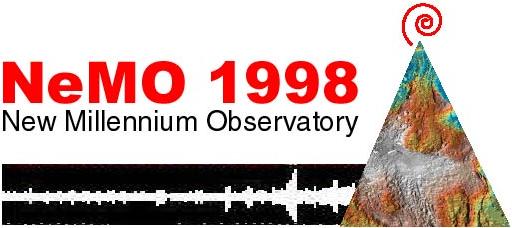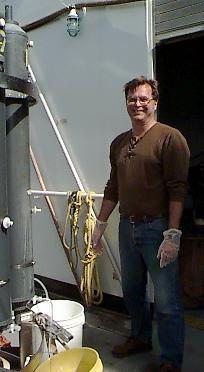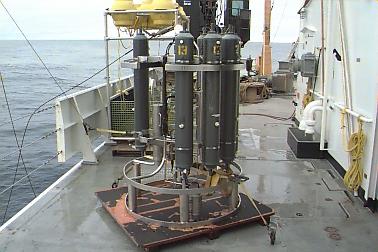WHAT'S NEW:
Deepsea Image Galleries on Multimedia page
(posted 9/15/98)
Eruption Confirmed!
New lava (rumbleometer stuck in flow) SE rift zone
(posted 9/1/98)
BACKGROUND:
Technology (ROV, ships, etc.)
Other 1998 Axial cruise reports
EXPEDITION:
Science Objectives
Calendar
Today's Science News
Participant Perspective
Teacher Logbook
EDUCATION:
Curriculum
Teacher Observations
Questions/Answers from sea
MULTIMEDIA:
(video clips, animations, sounds)

Logbook
September 17, 1998
September 17, 1998
Contents:
Science Report
Listing of all Science News postings
Life at Sea: Participant Perspective
Jim Gendron
NOAA Vents Program, Seattle

My name is Jim Gendron. I am an oceanographer with NOAA's Pacific Marine Environmental Lab in Seattle. My main interest is the 'smoke' that forms above the hydrothermal sources. This hydrothermal particulate is composed of very small grains of material that precipitate rapidly after leaving the vent. As the particles form they become the characteristic rising plume that you see. Just like smoke from a smokestack, this plume can ascend up to 200 meters from it's source.
How do you detect such a plume?
One of the instruments on the CTD is called a nephelometer. It shines a
light into the water and then detects any light that is scattered back to
it's sensor. The brighter the returning light signal is, the more particles
there are.

How do you collect samples of the particles? Samples can be collected using the Niskin bottles on the CTD (gray, tubular items in photo on left), or by mounting Niskins directly on ROPOS. The fluid sampler on ROPOS can also be used to filter the plumes in place. In all cases the samples are filtered onto plastic membrane filters. Then they are dried and kept under a vacuum until they are brought back to the lab in Seattle.
How do you analyze the samples? Each sample is placed in a instrument that blasts it with X-rays. The sample will then give off new X-rays that can be used to tell what elements are present and how much of each element is in the sample.
What elements do you find in the 'smoke'? The most important elements are iron, sulfur, zinc, copper, silica, manganese and phosphorus. The orange-brown color that you can see in much of the sediment cover on the basalt is probably due to iron.
Consider the following: These hydrothermal vent systems were not discovered until after humans had walked on the moon.
Listing of all Perspectives postings
Teacher At Sea Logbook
September 17 - 1100 hours
If there was any doubt that fall is just around the corner is was dispelled last night.. Those squalls that blew the ship off station yesterday turned into winds that peaked over 30 knots, and the confused sea-state made it impossible to get ROPOS back in the water. It also made sleeping in an upper bunk in the forward part of the ship a hit-and-miss affair. ROPOS is still on the aft deck.
Bob Embley and the ROPOS technicians are meeting out there trying to decide whether or not to try for a launch. We have apparently reached the center of this low pressure and, like the eye of a hurricane, things have temporarily calmed down. Of course as we come back out the other side we can expect increasing winds, but from the other direction. That may actually help to knock down some of the seas that are keeping ROPOS on the deck.
There are two dangers in launching ROPOS in marginal conditions. Of course the first is that with the ship lurching back and forth there is always the chance of slamming the sub against the ship. The second danger comes from what is know as a "snap load". This is the tension that is applied to the tether when the cage is suddenly pulled up and down violently by the action of the ship. It is usually during the extreme tension of a snap load that something gets separated in the tether. This could potentially lead to anything from another major retermination to loss of the sub. No one wants to take a chance on either of those. A full retermination would probably end the expedition right here since there would be little or no time left after repairs.
At the very least scientists want the extensometers in place and other bacteria traps and temperature probes back on the ship. So for now we watch the weather computer screens and wait for an opening. I go on watch at 1200 hours. It will either be four hours of thumb-twiddling, or a hectic race to beat the weather. More later.
2030 hrs
We have been high and dry all day. The barometer has dropped, winds have been steady at better than ten knots and the pilots don't like the look of the current swell, so we are in a holding pattern, hoping to get in at least one more dive before we break camp. Regardless of weather or work undone, we depart for Victoria at 0400 hours on Saturday morning, so if the last dives happen it will be later tonight and again tomorrow.
There is not much else to report tonight. The scientists are beginning to work on their summaries for the cruise log that will be published soon. Their homework assignment, and mine, is to have the summary written and submitted to the chief scientist before we land in Victoria. Other than that the big news on board is that the cribbage tournament was won by someone who spent a good deal of his freshman year at the University of Washington playing cards when he should have been studying. That would be yours truly.
Logbook of all Teacher At Sea postings
Question/Answer of the Day
Send Your Question to NeMO
(oar.pmel.vents.webmaster@noaa.gov)
Back to Calendar